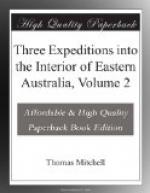Were it expedient to enter here into further details, or upon a longer description of the natives of Australia, I might quote largely from Captain Cook’s account of those he saw at Adventure Bay, Van Diemen’s Land, as being more detailed and descriptive, both of the natives in the interior, and of those also around the whole circumference of Australia, than any I could give. In the descriptions by Dampier and other navigators who have touched on any part of these shores we recognise the same natives with all their characteristics, and are led to conclude that they are derived from the same stock and, as the judicious compiler of the first History of New Holland considered it most probable from this and other circumstances “that the number is small, and that the interior parts of the country are inhabited,"* I may observe that I have had no reason to entertain a contrary opinion from what I saw of the interior country beyond the Darling. The native population is very thinly spread over the regions I have explored, amounting to nearly a seventh part of Australia. I cannot estimate the number at more than 6000; but on the contrary I believe it to be considerably less. They may increase rapidly if wild cattle become numerous; and as an instance I may refer to the number and good appearance of the Cudjallagong tribe near Macquarie range where they occasionally fell in with a herd of wild cattle.
(Footnote. History of New Holland pages 31 and 232.)
DESTRUCTION OF THE KANGAROO.
The kangaroo disappears from cattle runs, and is also killed by stockmen merely for the sake of the skin; but no mercy is shown to the natives who may help themselves to a bullock or a sheep. Such a state of things must infallibly lead to the extirpation of the aboriginal natives, as in Van Diemen’s Land, unless timely measures are taken for their civilisation and protection. I have heard some affecting allusions made by natives to the white men’s killing the kangaroo. At present almost every stockman has several strong kangaroo dogs; now it would be only an act of justice towards the aborigines to prohibit white men by law from killing these creatures which are as essential to the natives as cattle are to the Europeans. The prohibition would be at least a proof of the disposition of the strangers to act as humanely as they possibly could towards the natives. If wild cattle on the contrary become numerous the natives also might increase in number and, if not civilised and instructed now, might become formidable and implacable enemies then, as no absolute right to kill even wild cattle would be conceded to them. The evils likely to result from such circumstances were apparent both in the commencement and termination of my first journey; but although the desert character of the interior renders such a state of things less likely to happen, at least on a larger scale, the unfortunate race whom we have found on the shores of Australia are not the less entitled to our protection.




